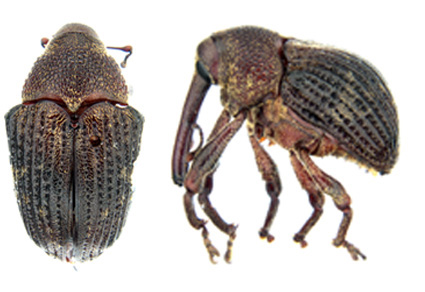Abstract
Alcidodes (Curculionidae) is a hyperdiverse group of weevils that pose a potential threat to various crop species, trees, and other plants. Through a combination of morphological and genetic analyses, we have identified a previously undescribed species of this genus, which we name Alcidodes erosa Mithun, Mahendiran & Pooja sp. nov. The validity of the new species is supported by both morphological and molecular data. All known adult specimens were collected from the critically endangered tree species, Hopea erosa (Bedd.) Slooten (Dipterocarpaceae), which is endemic to the Western Ghats. A recent assessment by the IUCN indicates that fewer than 200 individuals of this tree species exist and it is estimated that approximately 78-82% of seed damage is caused by Alcidodes erosa.
References
- Deepu, S., Sanil, M.S. & Sreekumar, V.B. (2021) Hopea erosa. The IUCN Red List of Threatened Species, 2021, e.T31168A115931930. https://doi.org/10.2305/IUCN.UK.2021-2.RLTS.T31168A115931930.en
- Haaf, E. (1961) Die Alcidodes der Indochinesesischen subregion (Col. Cur.). Entomologische Arbeiten aus dem Museum G.Frey, 15 (1), 134–220.
- Heller, K.M. (1918) Die philippinischen Arten der Russelkafer gattung Alcides Schonh. Stettiner Entomologische Zeitung, 78 (2), 209–245.
- Hoang, D.T., Chernomor, O., von Haeseler, A., Minh, B.Q. & Vinh, L.S. (2018) UFBoot2: Improving the ultrafast bootstrap approximation. Molecular Biology and Evolution, 35 (2), 518–522. https://doi.org/10.1093/molbev/msx281
- Kalyaanamoorthy, S., Minh, B.Q., Wong, T.K.F., von Haeseler, A. & Jermiin, L.S. (2017) ModelFinder: fast model selection for accurate phylogenetic estimates. Nature Methods, 14 (6), 587–589. https://doi.org/10.1038/nmeth.4285
- Katoh, K., Rozewicki, J. & Yamada, K.D. (2019) MAFFT online service: multiple sequence alignment, interactive sequence choice and visualization. Briefings in Bioinformatics, 20 (4), 1160–1166. https://doi.org/10.1093/bib/bbx108
- Lyal, C.H.C. & Curran, L.M. (2000) Seed-feeding beetles of the weevil tribe Mecysolobini (Insecta: Coleoptera: Curculionidae) developing in seeds of trees in the Dipterocarpaceae. Journal of Natural History, 34 (9), 1743–1847. https://doi.org/10.1080/00222930050122165
- Mahendran, B., Agnihotri, M. & Pillai, K. (2014) A new species of parasitoid wasp Euderus (Eulophidae: Chalcidoidea: Hymenoptera) from Uttarakhand, India on Dainha shoot weevil. Madras Agricultural Journal, 101, 155–158. https://doi.org/10.29321/MAJ.10.001172
- Marshall, G.A.K. (1939) New tropical African Curculionidae (Col.). Annals and Magazine of Natural History, Series 11, 3 (18), 561–583. https://doi.org/10.1080/03745481.1939.9723637
- Morimoto, K. & Kojima, H. (2007) Taxonomic notes on the tribe Mecysolobini (Coleoptera, Curculionidae), with Descriptions of three new taxa from Japan. Elytra, 35 (1), 226–237.
- Minh, B.Q., Schmidt, H.A., Chernomor, O., Schrempf, D., Woodhams, M.D., von Haeseler, A. & Lanfear, R. (2020) IQ-TREE 2: New models and efficient methods for phylogenetic inference in the genomic era. Molecular Biology and Evolution, 37 (5), 1530–1534. https://doi.org/10.1093/molbev/msaa015
- Nakagawa, M., Itioka, T., Momose, K. & Nakashizuka, T. (2005) Insect Predators of Dipterocarp Seeds. In: Roubik, D.W., Sakai, S. & Hamid Karim, A.A. (Eds.), Pollination Ecology and the Rain Forest. Ecological Studies. Vol. 174. Springer, New York, New York, pp. 145–157. https://doi.org/10.1007/0-387-27161-9_13
- Pajni, H.R. & Dhir, S. (1987) A generic revision of the subfamily Alcidodinae with the proposal of seven genera (Alcidodinae: Curculionidae: Coleoptera). Research Bulletin (Science) of the Punjab University, 38 (1–2), 27–34.
- Praveena, S., Sujanapal, P., Jose, P.A. & Sreeraj, K.B. (2024) Pre-sowing treatment strategies for improving seed germination rates in Hopea erosa (Dipterocarpaceae), a critically endangered tree of the Southern Western Ghats. Vegetos. [published online] https://doi.org/10.1007/s42535-024-01096-8
- Rajaram, V., Benish, R.P.M., Jothiramsekar, S., Palanisami, E., Manoli, M.J. & Nadesa, P.A. (2013) Antioxidant Activities of Wood and Leaf Extracts of Hopea erosa. Journal of Biologically Active Products from Nature, 3 (2), 154–160. https://doi.org/10.1080/22311866.2013.817746
- Rambaut, A. (2018) FigTree. Version 1.4.4. Institute of Evolutionary Biology, University of Edinburgh, Edinburgh. Available from: http://tree.bio.ed.ac.uk/software/figtree/ (accessed 7 September 2025)
- Singh, S. (2005) Description of a new species of Euderus (Hymenoptera: Chalcidoidea: Eulophidae), an egg parasitoid of Alcidodes ludificator (Coleoptera: Curculionidae) a pest of Gmelina arborea. Entomon, 30, 321–326.


